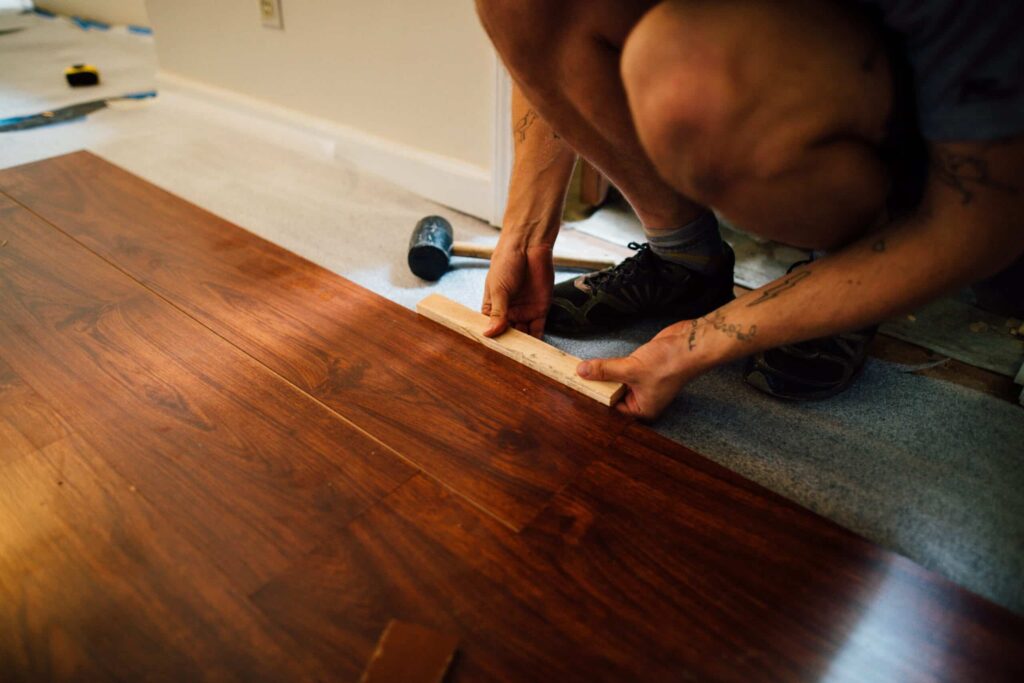
Laying laminate floors is a pleasurable DIY project that can transform your house. However, there are a number of common errors people make while installing laminate floors. In this effective guide, Nova Floor has enlisted 10 common mistakes related to Laminate flooring installation. Knowing these mistakes and how to avoid them will give your finish a professional look. Avoid these ten common mistakes when laying laminate flooring.
1. Leaving Out Acclimatization
One of the most common mistakes when laying laminate flooring is skipping acclimatization. Laminate flooring takes time to get used to your house’s humidity and temperature. If you do not let the laminate acclimate, it might grow or contract after installation, resulting in buckling or gaps. To prevent this, keep the unopened boxes of laminate floors within the room where they’ll be fitted for more than 48 hours before putting them in.
2. Not Preparing the Subfloor Properly
A well-maintained, dry, level subfloor is essential for a successful laminate flooring installation. Not preparing the subfloor can produce an uneven surface where the laminate flexes and possibly breaks. Clean the subfloor, remove debris, and check for uneven places. You might have to sand high areas or fill low spots to make a level surface.
3. Ignoring Underlayment
Underlayment cushions the laminate against the subfloor and reduces noise and stability. Skipping this step can result in a noisy floor that feels unstable. Use the right underlayment on your laminate flooring and lay it flat without gaps or overlaps.
4. Incorrect Measurements
Accurate measurements are essential when laying laminate flooring. If you do not measure correctly, you might have too short or too long parts, wasting materials and producing an uneven finish. Measure the length and width of the room, plus some for cutting errors and waste. But remember the rule: measure twice, cut once.
5. Not Allowing Expansion Gaps
Laminate flooring expands and contracts as temperature ranges and humidity change. Without an expansion gap around the outside of the room, the floor can buckle and warp. Leave more than 14 inches (six mm) between the floor and the walls and utilize spacers to close this gap.
6. Poor Staggering of Planks
Staggering the planks in a random or uniform pattern strengthens your floor. Placing planks end to end without staggering can produce weak points and an unattractive finish. Try to stagger the pattern so that the end bones of the planks are twelve inches (thirty cm) apart.
7. Cutting Corners on Tools
The incorrect tools may make installation harder and lead to a poor finish. Buy quality tools—a laminate flooring cutter, a jigsaw for precise cuts, and a tapping block to fit the planks together without harming them. The proper tools will save you frustration and time.
8. Incorrect Installation of Transitions
Transitions are precisely where your laminate flooring meets other flooring choices, like carpet or tile. Incorrectly installed transitions may create tripping hazards and a messy appearance. Use the appropriate transition pieces and stick to manufacturer directions for a safe transition between flooring types.
9. Rushing the Installation
Installing laminate floors requires time and patience. Rushing the process may cause gaps, uneven edges, and ruined planks. Be sure each plank is put in and secured. If you’re working on a large area, break the project into smaller components to limit mistakes and fatigue.
10. Neglecting Post-Installation Care
When your laminate flooring is installed, it must be well looked after. Failing post-installation care could cause scratches, stains, and other damage. Avoid dragging heavy furniture across the floor, use protective pads underneath furniture legs, and wash the floors frequently with a damp mop and a laminate flooring cleaner.
Closing Thoughts
Avoiding these common mistakes can ensure a gorgeous laminate floor installation. This is a reminder to acclimatize your floors, assemble the subfloor, and do the best measuring and underlayment. Leave expansion gaps, stagger the planks, use quality tools, and install transitions correctly. Take your time with all the installation and adequately care for your floor once it is installed. Using these tips, you’ll have a laminate floor to look forward to for decades. Happy flooring!
- 4shares
- Facebook0
- Pinterest1
- Twitter3
- Reddit0



